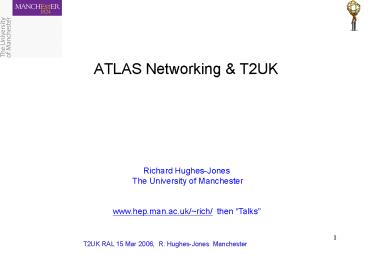ATLAS Networking - PowerPoint PPT Presentation
1 / 12
Title:
ATLAS Networking
Description:
New Network Topology with all links carried by G ANT and NRNs. Planned Investigations ... Setup the WAN emulator with the measured conditions ... – PowerPoint PPT presentation
Number of Views:15
Avg rating:3.0/5.0
Title: ATLAS Networking
1
ATLAS Networking T2UK
Richard Hughes-Jones The University of
Manchester www.hep.man.ac.uk/rich/ then
Talks
2
Remote Computing Farms
- Discussion at CERN to establish a work-plan for
2006 - Valuable for Monitoring and Calibration
- MOU Alberta CERN Krakow Manchester
- New Network Topology with all links carried by
GÉANT and NRNs - Planned Investigations
- Characterise the new network links and end host
performance - Toolsiperf udpmon thrulay yatm
- Measure the ATLAS request-response behaviour
- Tools tcpmon, web100 tcpdump
- Setup the WAN emulator with the measured
conditions - Compare network and ATLAS traffic observations
- Install and test ATLAS application gateway (as
used at the pit) - Test deployment of Online TDAQ HLT releases
- Measure performance of Online TDAQ HLT releases
- Consider how to link Real-Time T/DAQ to remote
Grid farms - First draft of Work Plan document circulated
3
Network Operation Performance
- Analysis of Fault Tolerance in ATLAS T/DAQ
Networks - Document the action of the switches
- Fate of the packets
- Effect on T/DAQ applications
- Networks Considered
- Front End (DataFlow) Network
- BackEnd Network
- Controls Network (Run control, services, some
monitoring) - Consider questions like
- Failure of a link between the ROS and the ROS
Concentrator Switch - Draft Document being discussed
- Performance tests discussed
- The PCI-e 4 1GE PEG4 NIC Silicom.
- Simple and trunking Throughput
- ROS SuperMicro Motherboard
- 6 PCI, 1 4 lane PCI-e, one 3.4 GHz Xeon (dual
socket)
4
Network Monitoring in ATLAS T/DAQ
- Levels of Monitoring
- SNMP Statistics MRTG, RRD, YATM higher sample
rate - Traffic patterns, bytes, packets NOT dropped
packets - Network test programs udpmon, iperf
- Throughput loss 1-way delay rtt
- Standalone ATLAS test programs speaking the TDAQ
application protocol. - Richard
- ATLAS test programs speaking the TDAQ application
protocol using TDAQ APIs - Stefan
- Monitoring by the TDAQ application itself
- Integration of Message Passing Libraries
- DataFLow (Reiner) and EF (Mario) main difference
in substantiation of buffers - Integrate over common thin shim over the socket
calls - Idea to put monitoring into (common) message
passing layer - What can be observed?
- Question of keeping state Application would be
the best place !
5
Related Work RAID, ATLAS Grid
- RAID0 and RAID5 tests
- 4th Year MPhys project last semester
- Throughput and CPU load
- Different RAID parameters
- Number of disks
- Stripe size
- User read / write size
- Different file systems
- Ext2 ext3 XSF
- Sequential File Write, Read
- Sequential File Write, Read with continuous
background read or write - Status
- Need to check some results document
- Independent RAID controller tests planned.
6
ESLEA ATLAS Grid on UKLight
- Demonstration of benefits of Dedicated links
- 1 Gbit Lightpath Lancaster-Manchester
- Disk 2 Disk Transfers
- Storage Element with SRM using distributed disk
pools dCache xrootd
7
Check out the end host bbftp
- What is the end-host doing with your application
protocol? - Transatlantic bbftp over TCP/IP
- Look at the PCI-X buses
- 3Ware 9000 controller RAID0
- 1 Gbit Ethernet link
- 2.4 GHz dual Xeon
- 660 Mbit/s
8
- Any Questions?
9
- Backup Slides
10
TCP Stacks CPU Load
- Real User problem!
- End host TCP flow at 960 Mbit/s with rtt 1 ms
falls to 770 Mbit/s when rtt 15 ms
11
A Few Items for Discussion
- Achievable Throughput
- Sharing link Capacity (OK what is sharing?)
- Convergence time
- Responsiveness
- rtt fairness (OK what is fairness?)
- mtu fairness
- TCP friendliness
- Link utilisation (by this flow or all flows)
- Stability of Achievable Throughput
- Burst behaviour
- Packet loss behaviour
- Packet re-ordering behaviour
- Topology maybe some simple setups
- Background or cross traffic - how realistic is
needed? what protocol mix? - Reverse traffic
- Impact on the end host CPU load, bus
utilisation, Offload - Methodology simulation, emulation and Real
links ALL help
12
More Information Some URLs 1
- UKLight web site http//www.uklight.ac.uk
- MB-NG project web site http//www.mb-ng.net/
- DataTAG project web site http//www.datatag.org/
- UDPmon / TCPmon kit writeup http//www.hep.man
.ac.uk/rich/net - Motherboard and NIC Tests
- http//www.hep.man.ac.uk/rich/net/nic/GigEth_te
sts_Boston.ppt http//datatag.web.cern.ch/datata
g/pfldnet2003/ - Performance of 1 and 10 Gigabit Ethernet Cards
with Server Quality Motherboards FGCS Special
issue 2004 - http// www.hep.man.ac.uk/rich/
- TCP tuning information may be found
athttp//www.ncne.nlanr.net/documentation/faq/pe
rformance.html http//www.psc.edu/networking/p
erf_tune.html - TCP stack comparisonsEvaluation of Advanced
TCP Stacks on Fast Long-Distance Production
Networks Journal of Grid Computing 2004 - PFLDnet http//www.ens-lyon.fr/LIP/RESO/pfldnet200
5/ - Dante PERT http//www.geant2.net/server/show/nav.0
0d00h002





![[PDF] National Geographic Family Reference Atlas 5th Edition (National Geographic Family Reference Atlas of the World) Kindle PowerPoint PPT Presentation](https://s3.amazonaws.com/images.powershow.com/10089882.th0.jpg?_=20240801021)

























